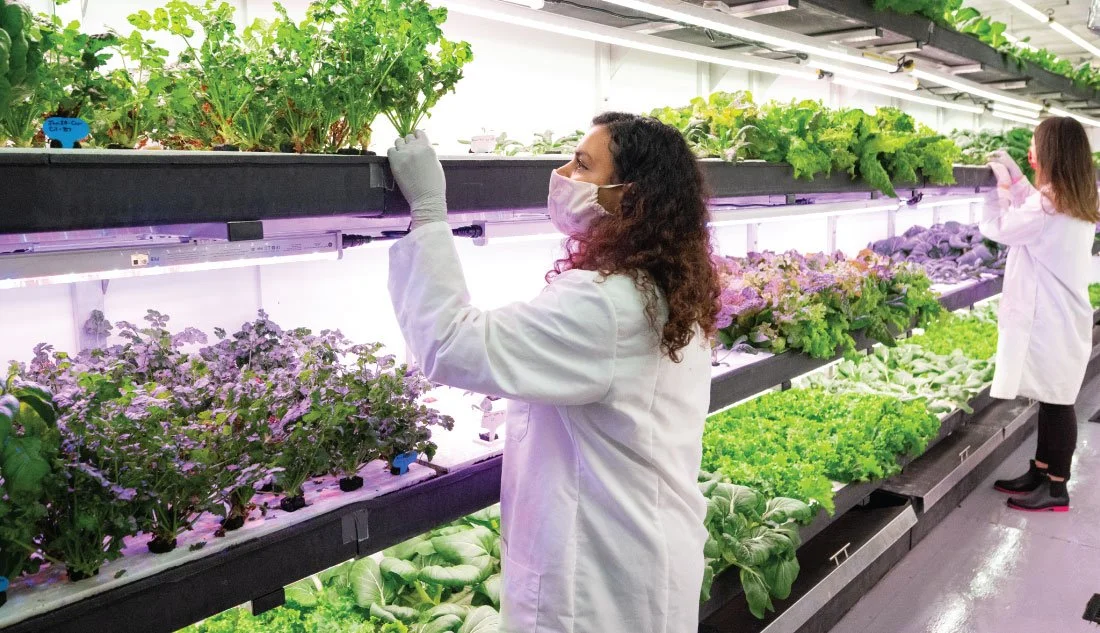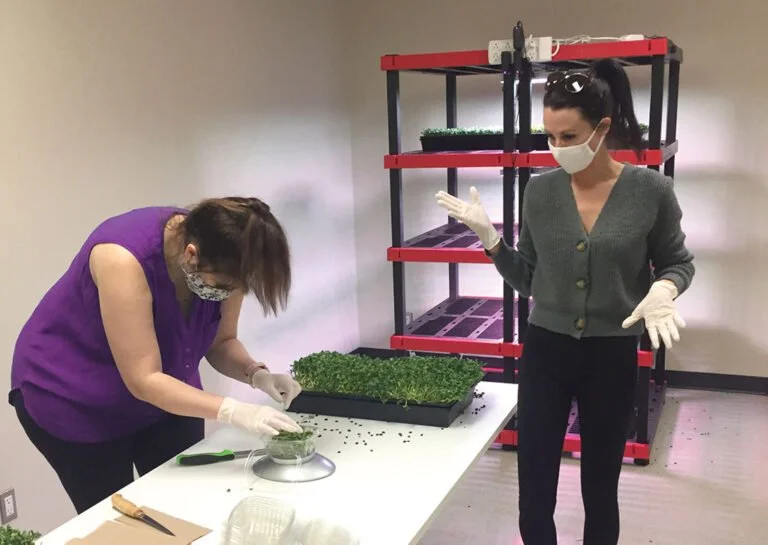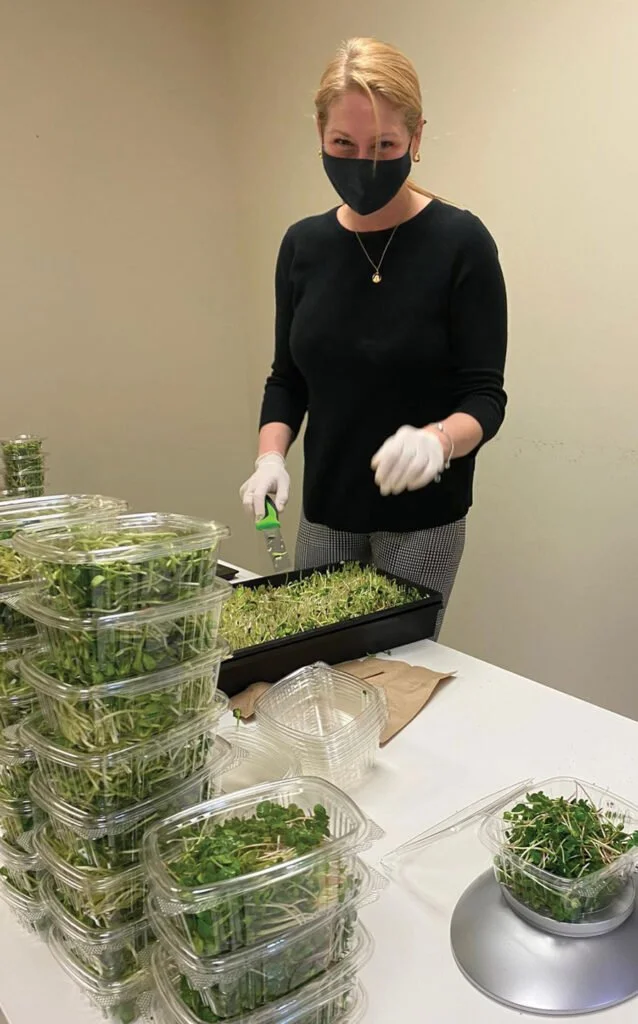Feeding And Teaching The Future
Four companies are taking matters into their own hands and bringing innovation to the forefront
17 June 2022
THE GROWCER
It was back in their university days when Alida Burke and Corey Ellis had their a-ha moment. The two belonged to a campus club focused on social entrepreneurship called Enactus uOttawa. In the second semester of their first year, Burke and Ellis had the opportunity to travel with the club to Iqaluit, Nunavut’s capital. “This trip opened our eyes to the challenges faced by northerners around food insecurity. We experienced the common ‘sticker shock’ of food prices when we visited a local grocery store,” Burke remembers.
During their trip, the group spoke to folks who cared about solving food security in the northern territory. “It’s an endlessly complex issue and there isn’t a one-size-fits-all solution. The idea to grow food indoors was one that arose during the discussions with community members and became the catalyst for the Growcer today,” she says. “Specifically, using durable, containerized hydroponic systems to grow food in the tundra. We then found that the modular farm also has sustainable applications outside of the north because it requires less water, less land and fewer resources overall to grow produce than conventional farming.”
Burke and Ellis returned to Ottawa with a new mission — to help people grow fresh, hyper-local, high-quality produce year-round using hydroponic modular farms (in this case, farms are basically custom-built insulated structures the size of shipping containers). The pair’s company, dubbed the Growcer, does just this — it uses hydroponics (nutrient-rich water instead of soil and special plant lights instead of sun) and stacks plants to grow more lettuce, kale, spinach and herbs in smaller spaces. “By harnessing the power of hydroponics, we unlock growing food for more people using less water, less land and fewer pest-control products,” Burke explains.
The team’s growing technology was first used in Churchill, Man., a remote, food-insecure community like Iqaluit. “Our first farm sees temperatures drop as low as minus-50 degrees Celsius. Since that one, we’ve deployed more than 35 farms across Canada and partnered with schools, nonprofits and non-remote communities that see value in growing food locally,” she says. What’s more, the Growcer has been able to close the gap between producer and consumer. Installing a modular farm is easy — its only requirements are a flat surface, power and a water connection. “Embrun Co-op outside of Ottawa uses its Growcer farm to grow fresh greens steps away from the produce aisle in its grocery store. In the process, they’re eliminating emissions associated with travel times to stores,” she adds.
So far, communities and institutions across the country have used Growcer farms to grow more than one million servings of local, nutritious greens. Each farm is locally run — locals decide what to grow, how much to grow and where to sell or donate produce. “In Manitoba’s Norway House Cree Nation, two operators grow fresh produce for the local school. The chef and student chefs at the school support the local business by making the most of the fresh ingredients in the cafeteria and in cooking classes. For example, they even steam and vacuum seal spinach for the home economics classes to make spinach dip, soups and quiches. Local empowerment is a key pillar of the Growcer model, and it’s also what keeps it exciting. Each project is different because each community is different.”
Today, folks find the Growcer through a variety of ways, including at economic development conferences and on television — Burke and Ellis took their idea to Dragons’ Den. What’s special is how areas across the country are using the Growcer to better their communities. Burke says Altario School in Alberta creates one-of-a-kind agriculture education, where students can learn about indoor agriculture using its Growcer farm. Squamish Nation uses its Growcer farm to grow fresh produce for their community kitchen and pantry that supports Ayás Mén’men Child and Family Services. Gitmaxmak’ay Nisga’a Society runs a fresh greens subscription box in one of Canada’s rainiest cities and donates the surplus to community members in need.
“So far, it’s been an overwhelmingly positive experience. Our customer success team gets to celebrate wins on the daily and Growcer’s community of growers motivate us to keep doing what we do,” she says. “To see the impact individuals have made on their communities by growing food — and to be a small part of it — is incredibly rewarding. It’s about more than food — it’s about working every day for a healthier, more sustainable future. Growing local food also creates local jobs, training and education opportunities and new economic development. We can use business as a force for good for a healthier, sustainable future.”
PROJECT GREEN
What do you get when your colleagues decide to grow produce together? For Oshawa, Ont.’s Spark Centre (the company that publishes this magazine), you get an ingenious idea that helps locals and give folks who need it most access to nutrient-rich microgreens on the daily.
It was the beginning of the pandemic when president and CEO Sherry Colbourne says she noticed there were more people living on the streets of Oshawa. “I often thought about how they must be coping and spoke to a local community police officer about it. Around the same time, the Digital Mainstreet Program was rolled out, and Spark Centre was chosen to administer some funds for the Community Collaboration Program, which focused on bringing together community members to collaboratively identify and solve one or more local main-street challenges. It seemed obvious to me that feeding these people was one of the problems we should solve.” Colbourne says one of Spark Centre’s clients, Food Security Structures Canada, introduced her team to hydroponic growing technology. “Together we embarked on a journey to demonstrate how hydroponic technology could be used on a micro-local level to be a source of nutritious food.”
Colbourne’s team isn’t made up entirely of gardeners, but they all love helping their communities. While a few had experience planting, others were quick to step up and willing to learn. It was truly a shared desire to help the local homeless population that launched what they affectionally refer to as “Project Green.” When they started the experiment to see what they could grow and yield, Colbourne says they tried a number of microgreens but it didn’t take long for them to hone in on the hardiest varieties. “We grew sunflower, radish, mustard and broccoli. All delicious additions to salads, curries, soups and sandwiches,” she says. And when it comes to how much they grew, Colbourne says it was more than they ever would’ve guessed. “We surprised ourselves with our growing talent and delivered more than 360 containers of microgreens to our local YWCA, Back Door Mission and Gate:316 (Durham Outlook).” In total, Spark Centre’s green thumbs grew 10 kilograms of produce over their three-month pilot project.
“This important initiative brought us closer to our community. We worked with our community stakeholders, the client whose technology made it all possible, our staff and even some of our co-working residents,” Colbourne says. The Spark Centre team has plans to share what they know — the technology and skills behind Project Green will now be transferred to the folks at the Back Door Mission so they can take over operation and be able to grow delicious, healthy microgreens.
Spark Centre’s staff help water, grow and harvest microgreens and other popular leafy greens as part of the three-month pilot.
TWO BLOKES CIDER
There are two things fifth-generation farmer Matthew Somerville plans to do with his acreage in Scugog. The first is the story of how the industrious urban planner turned six of those acres into Seagrave, Ont.’s first cidery. The second is a brilliant idea, still in its incubation phase, that will see locals learn how to grow their own sustainable produce. Both concepts are equally important, and both will take a lot of work, which doesn’t seem to bother Somerville. He’s already proven determination, hard work and a great idea can go a long way.
A desire to find a future for his family farm inspired Somerville to open the cidery. “A lot of these farms are disappearing.There’s a big tradition of agriculture around here, but it’s eroding and working family farms are becoming harder to find,” he says. His family farm had cattle up until the mad cow crisis of 2003. “I was in university studying sustainability and I witnessed first-hand the acceleration of loss of family farms. The market fell and we sold off our herd. Our farm went silent first time in my life, and I saw it happen to other farms.” Years later, after getting a degree in urban planning, Somerville was across the pond pondering his next move when he had a bit of an epiphany. “I was sitting in a restaurant and had a cider that tasted just like the cider we made on our farm when I was a kid. It was like a spark went off in my head,” he says. He took a sabbatical from his job and went back to England to study cider making. “Not a lot of urban farmers come from an agricultural background, but I wanted to link the two together,” he says. Soon after, he ended up meeting his husband and business partner, Andy Paul, after they both returned home to Canada after spending time in England. They bonded over the United Kingdom and cider — two things they didn’t realize they had in common until they were back on Canadian soil.
Skip ahead to 2012 and the pair planted their first test orchard — 150 trees using cider fruit (as opposed to regular culinary apples). Three years later, they planted another 3,000 trees. “We found our niche, but it takes time to grow,” says Somerville. Their first harvest was in 2019 and they opened Two Blokes to the public in June 2021. This summer promises to be a big one for the duo — they’re tripling production and are bringing out their delicious varieties, Hop My Cherry and Gosework Orange, along with their traditional ciders. “Cider is celebratory. It’s a value-added good that has lineage in this area,” he says, adding the farm will also host a “Queers to the Country” event in August, and a culinary do in September.
“This is an idea that has merit and must move forward. It’s great I can link together my planning background, farming and innovation and help to create a more sustainable food system.”
The cidery, though, is one spoke in a much larger wheel of farm enterprises that Somerville and Paul are considering. One in its infancy is all about using the remaining 114 acres of the farm to help develop a new generation of farmers. “The idea,” he says, “is to reduce barriers when it comes to access to land, reduce barriers to capital and create a hub where people can access the area and grow their own produce. I see it as a horizontal office lease that’s long term — taking two acres or five acres of space, for example, sharing irrigation, sharing cold storage and tractor use and eliminating the cost of the land, which is so expensive.” Giving people access to the land, capital and teaching them how to successfully farm and make their parcel bountiful is the epitome of a sustainable idea. “There’s so much space on the property and our proximity to Toronto is good, plus we’re in the greenbelt. There’s value in localizing food systems. I want to leverage my own privilege — I have access to this land and can build something innovative with it,” says Somerville, emphasizing he’s very early in the planning and conceptualizing stages now. “This is an idea that has merit and must move forward. It’s great I can link together my planning background, farming and innovation and help to create a more sustainable food system.”






